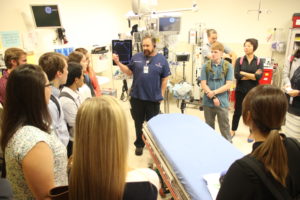By: Alessandra Santiago
Where you will apply for medical school? Do you know where you fall within the matriculation metrics of your target schools? Want to figure out what your target schools should be, but unsure of where to start?

Compiling your list of target schools is a key component in the admissions process, and it is a step that can really help clarify your application strategy come May 2020. It means knowing realistically what schools you might be admitted to given a number of factors:
- Your GPA score (cumulative as well as Biology-Physics-Chemistry-Mathematics, or BPCM)
- Your MCAT score
- Your state of residence
- Your personal alignment with a school’s mission statement
While you may not know your MCAT score yet, your GPA as it stands this fall semester is a good determination of where you might consider applying in May. The best way to assess where your GPA falls among members of previously matriculated classes is to register for Medical School Admissions Requirements (MSAR Online) through the AAMC (cost: $28).
Using the MSAR Online directory to select schools where you fall within the range of average GPA and MCAT scores—as well as schools where you may be slightly above or below the average—is a good idea.
For allopathic medical schools, MSAR Online reviews admissions statistics reported by medical schools around the country. This includes the school’s mean MCAT scores, as well as the ranges of the cumulative and BPCM GPAs of its current students. This data provides excellent foundational knowledge about whether or not you would be considered academically competitive at a particular school.
You can also filter schools based on state of residence. Many out-of-state schools accept a much smaller proportion of non-resident students (commonly, less than 15%), and some schools may not accept out-of-state students at all. You can filter your school selection on MSAR by searching using this out-of-state function. That said, there are some schools that admit over a quarter of their students from out-of-state, so these schools may be a good option, especially if you meet their academic metrics.

In addition to assessing your academic standing at a school, determining your personal ‘fit’ can also be found in the MSAR Online mission statement section. This section can give you a good idea about what each school’s ethos is: for instance, a school that highly emphasizes research in its mission statement may not be a good fit for a student who envisions their future career as a solely clinical practitioner and who has little to no meaningful research experience.
Consider also the academic requirements, financial aid, and class size of each school. There are plenty of factors to weigh when selecting schools, so it is a good idea to keep track of your rankings for each school.
You can use our ‘School Ranking’ table above to start getting a sense of what factors to consider when selecting schools. It’s a good idea to understand which schools are realistic targets, as well as which schools may actually be within your reach that you hadn’t considered previously.
Finally, the number of schools you select and to which you might eventually apply is entirely unique to your individual concerns. Some students only apply to 10-12 schools, while some apply to upwards of 30-40. Being realistic with the number you select based on where you fall in a particular school’s metrics can help you keep your numbers low. Keep in mind that the average cost per application is $38/school for the primary applications, and the cost per secondary application is $100. Consider short-term financial planning to afford the costs associated with applying (we will be covering financing in a future article).
| Assignment #5: Sign up for MSAR. Start looking through in-state schools, and consider out-of-state acceptance rates for other schools of interest. Download and start filling in the chart above to start assembling your application list. |
Stay tuned for our next big article. On November 4th, we will cover the behemoth: Prepping for The Primary Application! If you are interested in learning more about the application process or how to navigate the Pre-Med journey, visit our Getting Into Med School: Tips and Tricks Blog.
